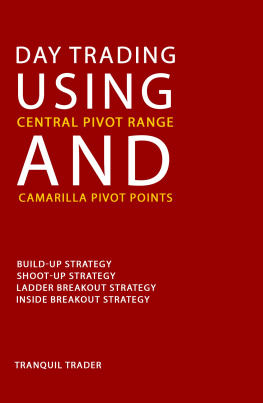| Day Trading Using Central Pivot Range and Camarilla Pivot Points |
| Tranquil Trader |
| Vibhatsu (Aug 2022) |
|
| Tags: | Trading, Day, CPR, Pivots, Technical Analysis |
| Tradingttt Dayttt CPRttt Pivotsttt Technical Analysisttt |
Day Trading is one of the fastest way to make money in the stock market.
There is hardly a more effective method for increasing a traders capital. Intraday offers several other key advantages. One advantage is the ability to use tight stop-loss orders and increased access to marginand hence, greater leverage.
The Day Trading using Central Pivot Points and Camarilla Pivot Points, I introduce you to the strategies and techniques which is a complete trading system for finding the best intraday trade entries! We will discuss Central Pivot Range (CPR) in detail along with Camarilla Pivot Points to find right trade setup.
The Strategy stated in the book is very easy to understand and can be applied immediately because it is universal and works in all markets.
Title Page
Day Trading Using
Central Pivot Range
and
Camarilla Pivot Points
Tranquil Trader
This ePUB is
re-compiled & gifted to book-lovers by
Vibhatsu
Contents
Preface
This book is written with the intention of enlightening your knowledge and awareness of different techniques of technical analysis. As a trader I strive to help educate my community of investors and traders. As an example of my commitment to that goal I want to provide this manual to you. I believe that continued education can help increase knowledge and through improved knowledge comes confidence.
Trading carries a level of risk that is not suitable for all people. The contents of this book are offered for information purposes only. Please seek professional financial advice before putting your money at risk with this or any other system.
If you are a trader who hungers for more in-depth knowledge of technical analysis, especially as it relates to methods of intraday trading, this book is for you!
I truly believe that no matter what level of trading experience you have, after reading this book, youll find you have likely enhanced your skill set and become an even more efficient and, most important, more profitable trader
Introduction
- Day Trading using Central Pivot Range and Camarilla Pivot Points, I introduce you to the strategies and techniques which is a complete trading system for finding the best intraday trade entries!
- With this course, you get a complete trading strategy with precise entry and exit rules
- Analyzing the market in a different manner, we are combining Central Pivot Range (CPR) & Camarilla Pivot Points to find high probable & profitable trades which is yet to impart in trading profession
- We will discuss Central Pivot Range (CPR) in detail along with Camarilla Pivot Points to find right trade setup
- I hope you find this book interesting and useful. If you have enjoyed this book then kindly recommend to others and please leave a review at Amazon.com
What is Central Pivot Range?
- Before we understand about Central Pivot Range, lets recap Pivot Point!
- Pivots Nothing but Support/Resistance calculated based on average price of high/low/close of previous day/week/month
- Pivots are purely derived from Price & hence are purely leading indicator
- On the subsequent day, trading above the pivot point is thought to indicate ongoing bullish sentiment, while trading below the pivot point indicates bearish sentiment
- There are five major types of Pivot Points Standard Pivot Points, Woodies Pivot Points, Camarilla Pivot Points, Fibonacci Pivot Points, and Demark Pivot Points. All these type of pivot points tells us the levels on the chart
- Lets approach CPR!
- CPR is same as Pivot point with 2 extra lines, TC (top central pivot) and BC (bottom central pivot) and Pivot is the central pivot point (PP). It is extracted from the Expanded floor pivots.
- Therefore these 3 lines TC, Pivot & BC contribute the CPR Zone. Hence CPR is not something a new indicator, its a part of Expanded floor pivots
Formulas
Standard Floor Pivots
| R3 | =R1+(High - Low) |
| R2 | =Pivot+(High - Low) |
| R1 | =2*Pivot-Low |
| Pivot | =(High+Low+Close)/3 |
| S1 | =Pivot-(High+Low) |
| S2 | =Pivot-(High-Low) |
| S3 | =S1 (High Low) |
Expanded Floor Pivot: Standard Floor Pivots +
| R4 | =R3+(R2-R1) |
| TC | =(Pivot-BC)+Pivot |
| BC | =(High+Low)/2 |
| S4 | =S3-(S1=S2) |
| Cell | Cell |
Expanded Floor Pivots
| R4 | =R3+(R2-R1) |
| R3 | =R1+(High-Low) |
| R2 | =Pivot+(High-Low) |
| R1 | =2*Pivot-Low |
| TC | =(Pivot-BC)+Pivot |
| Pivot | =(High+Low+Close)/3 |
| BC | =(High+Low)/2 |
| S1 | =2*Pivot-High |
| S2 | =Pivot-(High-Low) |
CPR ZONE
CPR
| TC | =(Pivot-BC)+Pivot |
| Pivot | =(High+Low+Close)/3 |
| BC | =(High+Low)/2 |
Key Points
- CPR is more accurate than traditional pivot points
- CPR is an analysis tool not designed for trade entries.
- CPR is very effective in determining the key levels for buy-sell decisions
- Works best when combined with another Indicator or additional Time Frame
- CPR are static and remain at the same price throughout the day. For higher timeframes, it remain the same throughout the Week/Month/Year Previous days Open High Low Close (OHLC) is referenced when you plot Todays CPR for 1, 3, 5, 10, and 15 minutes candles
- Previous weeks OHLC is a reference when you plot Current Week CPR for 30mins and 1-hour candles
- When you plot the End of Day (EOD) CPR, the previous months OHLC is referenced
- When you plot the Weekly CPR, the previous year OHLC is referenced
Characteristics of CPR
| Characteristics of CPR |
|---|
1. Trend Analysis |
2. Two day pivot range relationships |
3. CPR Width Forecasting |
1. Trend Analysis
- CPR trend analysis allows you to be disciplined to the trend by only buying in an uptrend, and selling in a downtrend
- If the CPR is ascending it is considered as a bullish trend & vice versa for a down trend
- Its more logical & viable to buy near support (CPR Zone) in a bull trend & sell near resistance (CPR Zone) in a downtrend
| Trend Analysis | |
|---|
| Ascending CPR | Bullish Trend |
| Descending CPR | Bearish Trend |
Ascending CPR Bullish Trend









